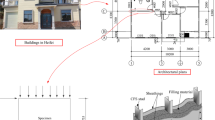Abstract
Four shear wall specimens made of high-performance concrete with blast-furnace-slag (BFS-HPC) are tested and studied under low frequency cyclic loading. Prior to the cyclic test, three specimens are subjected to elevated temperatures (400°C, 600°C) and two of them are mixed with polypropylene fiber. Based on experimental results, different curves are drawn and analyzed to study the seismic behavior of BFS-HPC shear walls after fire. They include load vs. lateral displacement hysteretic curves, load vs. lateral displacement skeleton curves, energy dissipation capacity curves, and stiffness degradation curves etc. Besides, the effect of polypropylene fiber on the seismic behavior of BFS-HPC shear wall after fire is also examined. This investigation demonstrates that elevated temperature exposure dramatically decreases the seismic performance of BFS-HPC shear walls, whereas polypropylene fiber can remarkably improve the seismic behavior of BFS-HPC shear walls after fire.
Résumé
Quatre essais sont étudiés pour des voiles en béton à hautes performances (BHP) à base de laitier de hautfourneau sous un chargement cyclique de basse fréquence. Trois échantillons sont soumis à une élévation de température (400°C, 600°C) et deux d'entre eux sont mélangés à de la fibre de polypropylène. Basé sur des résultats expérimentaux des courbes sont dessinées et analysées pour déterminer le comportement sismique des voiles en BHP après un feu et l'effet de la fibre de polypropylène sur le comportement sismique de voiles en BHP. Les courbes comprennent: les courbes d'hystérésie (chargement-déplacement latéral), les courbes squelettes chargement-déplacement latéral, les courbes de capacité de dissipation d'énergie, les courbes d'affaiblissement de rigidité du voile. L'étude a conclu que la haute température diminue gravement la capacité de comportement sismique de voile BHP, tandis que la fibre de polypropylène peut énormément améliorer le comportement sismique de voiles en BHP après un feu.
Similar content being viewed by others
References
Schneider, U., ‘Concrete at elevated temperatures—A general review’Fire Safety Journal 13(1) (1988) 55–68.
Xiao, J.-Zh. and König, G., ‘Study on concrete at elevated temperatures in China-An overview’,Fire Safety Journal 39 (1) (2004) 89–103.
Felicetti, R. and Gambarova, P.G., ‘Effects of elevated temperatures on the residual compressive strength of high-strength siliceous concrete’,ACI Materials Journal 95(4) (1998) 395–406.
Chan, S.Y.N., Peng, G.F. and Anson, M., ‘Fire behavior of high-performance concrete made with silica fume at various moisture contents’,ACI Materials Journal 96(3) (1999) 405–409.
Lennon, T. and Clayton, N., ‘Fire test on high-grade concrete with polypropylene fibers’, 5th International Symposium on Utilization of HSC/HPC, V. Z, June, 1999.
Dotreppe, J.C., Franssen, J.M. and Vanderzeypen, Y., ‘Calculation method for design of reinforced concrete columns under fire conditions’,ACI Structural Journal 96(1) (1999) 9–18.
Scott, T.S., Ronald, G.B. and Anthony, E.F., ‘Fire endurance of high-strength concrete slabs’,ACI Materials Journal 85(2) (1988) 102–108.
Grozier, A., and Sanjayan, G., ‘Tests of load-bearing slender reinforced concrete walls in fire’ACI Structural Journal 97(2) (2002) 243–251.
Huang, Zh.-H. and Platten, A., ‘Nonlinear finite element analysis of planar reinforced concrete members subjected to fires’,ACI Structural Journal 94(3) (1997) 272–282.
Paulay, T. and Priestley, M.J.N., ‘Seismic design of reinforced concrete and masonry buildings’ (John Wiley and Sons, New York, 1992).
Gupta, A. and Rangan, B.V., ‘High-strength concrete (HSC) structural walls’,ACI Structural Journal 95(2) (1998) 194–204.
Liu, Zh.-W. and Zhou K.R., ‘Experimental investigation on the seismic behavior of high performance concrete shear wall’, Chinese National Conference on HSC and HPC, (2001), 438–444. (only available in Chinese)
Xiao, J.-Zh., Schneider, H., Dehn, F. and Tue, N.V., ‘Experimental study on the fire-response of BFS-HPC shear walls’, Proceedings of the International Symposia on Role of Concrete Bridge in Sustainable Development, 3–4 September 2003, Dundee, 195–204.
Author information
Authors and Affiliations
Rights and permissions
About this article
Cite this article
Xiao, J.Z., Li, J. & Jiang, F. Research on the seismic behavior of HPC shear walls after fire. Mat. Struct. 37, 506–512 (2004). https://doi.org/10.1007/BF02481574
Received:
Accepted:
Issue Date:
DOI: https://doi.org/10.1007/BF02481574




